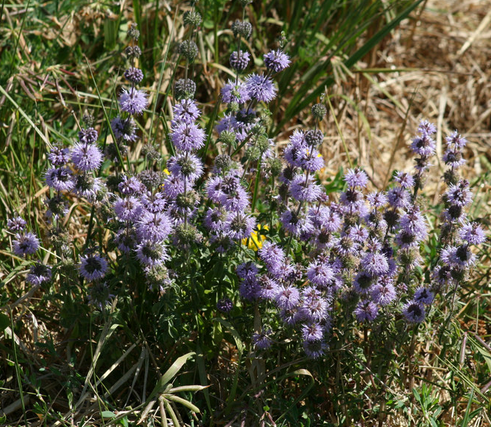
Pennyroyal (Mentha pulegium) is a member of the mint family, a perennial herb. It is a herb useful for its culinary, fragrance, medicinal and decorative uses.[1]
Description[edit | edit source]
Pennyroyal has small, oval-shaped leaves in a dark green colour. They are smooth. The leaves have a strong, pungent mint odour.
There is a European pennyroyal and an American pennyroyal.[1] The differences are minor and can be observed in the flowers (four stamens for the European and two for the American).[1]
Growing pennyroyal[edit | edit source]
Grow pennyroyal in the herb garden or as a border plant. It can also be grown as groundcover as it tolerates poor soil.[2] It can become invasive quite quickly, in the manner typical of members of the mint family. Planting in containers or surrounded by polyethylene bags can curb its spread.[1][2] If planting more than one, plant 25cm or 12 inches apart.
Plant in partial shade to full sun.[1] Pennyroyal prefers well-drained, rich soil that retains moisture.
It is not prone to many plant diseases.
Uses[edit | edit source]
Pennyroyal oil obtained simply from crushing the leaves and rubbing it on your skin can be useful for deterring insects such as flies, chiggers, ticks, mosquitoes, etc.[1] (See Caution below for the essential oil.)
Pennyroyal can be added to vinegar for a flavoured vinegar. It can be drunk as a tea.[1]
Cautions[edit | edit source]
Pennyroyal should not be used in large doses by pregnant persons.[1][2]
Do not use pennyroyal essential oil without being a qualified herbalist who knows its properties and how to apply it. The essential oil is highly toxic and ingestion or application of the oil is dangerous.[3] Pennyroyal should never be used on pet animals without veterinary advice; it can prove lethal.[4]
Sources and citations[edit | edit source]
- ↑ 1.0 1.1 1.2 1.3 1.4 1.5 1.6 1.7 http://extension.psu.edu/plants/gardening/herbs/pennyroyal-european
- ↑ 2.0 2.1 2.2 http://web.archive.org/web/20170520122003/http://extension.oregonstate.edu:80/gardening/node/695/print
- ↑ http://www.colostate.edu/Dept/CoopExt/4dmg/Pests/mosquit.htm
- ↑ http://solutionsforyourlife.ufl.edu:80/hot_topics/families_and_consumers/getting_rid_of_fleas.shtml